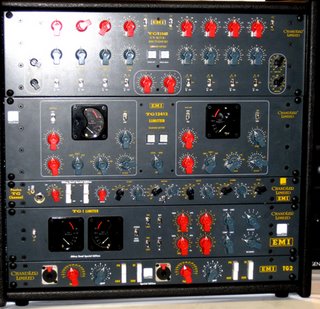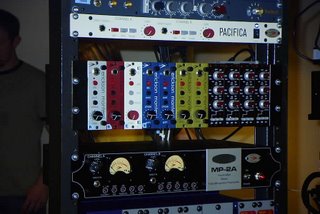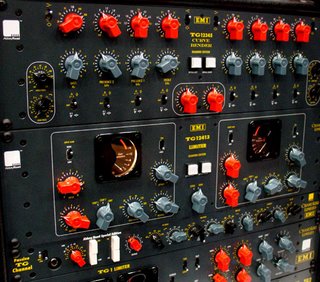I make the point of making it to every AES show I can for every year. Most of the time, the conference are held in Europe some where and rarely come to the US, so it is very hard for me to keep this up. I want to come to the conference to meet and to catch up with old friends, manufacture reps, and to find out if there is something new that I could learn which inturn will help my clients get more bang for the bucks.
 My first AES conference almost drove me crazy. Step into the conference hall, I would get blinded by the jungle of gears and 10,000 way of 'bleeding' the preamps’. Over the years, I had settle down and start to see right to the point of the show and spot what really stand out. I usually do my research first, read the previews, and then use the conference to 'drill' the reps, also to hear it for myself. It also helps to have friends who constantly calling me up to tell me about a new piece of gears which they like and want me to get for them. So every year, I want to go back for another specific reason, after all that. Recording production trend dictates where the manufactures put their money into R&D thus what they are cranking out of their production lines.
My first AES conference almost drove me crazy. Step into the conference hall, I would get blinded by the jungle of gears and 10,000 way of 'bleeding' the preamps’. Over the years, I had settle down and start to see right to the point of the show and spot what really stand out. I usually do my research first, read the previews, and then use the conference to 'drill' the reps, also to hear it for myself. It also helps to have friends who constantly calling me up to tell me about a new piece of gears which they like and want me to get for them. So every year, I want to go back for another specific reason, after all that. Recording production trend dictates where the manufactures put their money into R&D thus what they are cranking out of their production lines.
Tubes, Valve, Class A discreet line input, and your neighbor's wife...
These are some of the things at this year AES which is hot or trying to warm your mixes. Although DAWs have taken over for most kinds of audio production (especially Vietnamese market) getting signals into and out of digital recording platforms remains an analog process with everything from mixing boards to microphones (even computer sound cards perform analog-to-digital conversions). Analog technology is flourishing in a digital world.
I have nothing against DAW software plug in's, but that was 5 years ago. Shit happens and thing changes, so now back to the basic I go. One thing this year AES had only a few is the software plug in's booth. There were the Waves Hardware DSP and the Muse Research hardware DSP for VST plug in's but these booth were kind of...boring plus no one was around, seriously, I decided to stick with what's cool for this year audio toys.
 What I found and noticed about this year AES were analog channel strips, summing boxes, mic preamplifiers, compressors, and equalizers were everywhere. There was even a large format analog mixing console introduced by Solid State Logic, as well as a smaller format analog board called the ATB from former Trident designer Malcolm Toft, an 8-buss mixer available in 16/24/32 channel configurations and summing box from API, Chandler Unlimited, Speck, Tonelux etc.
What I found and noticed about this year AES were analog channel strips, summing boxes, mic preamplifiers, compressors, and equalizers were everywhere. There was even a large format analog mixing console introduced by Solid State Logic, as well as a smaller format analog board called the ATB from former Trident designer Malcolm Toft, an 8-buss mixer available in 16/24/32 channel configurations and summing box from API, Chandler Unlimited, Speck, Tonelux etc.My personal picks

What I really like about this year AES are pretty much personal choices, also that I had a chance to really fool around with some of these picks. API got my vote due to the fact that Bflat will rep for them in 
My suggestion is to start with a 16-channels DSM system which you can run your DAW hardware line output to and mix out of the box, you will not disappoint with how the DAW mix will open up. What so cool about the DSM system is that, it comes with TT Patch bay to integrate outboard gears with the your mixing environment with ease. Problem solved!
Preamps, Lunch Box, Valve, and the Beatles...Also at AES, API kicked off the VPR Alliance to standardize manufacturing for API’s Lunchbox “500 series” module rack, which can incorporate up to six devices (mic pres, EQ, compressors, etc.) in a small portable frame. Hardware manufacturers offering compatible modules now include Speck, Daking, Buzz Audio, ShinyBox, A Designs, Purple Audio, Avedis, Shadow Hills and Old School. Out of all those 'lunch meat' products for the API lunch box, I chose A-Design.

I met Peter thru Christ R. Murphy, who would not stop telling me how nice the A-Design preamps were. For those who never have experience with A-Design color, think Quad Eigh console, and if you still don't have a clue...think Pink Floyd's The Wall album. The sound will send chill up your spine. Peter Montessi and his team of audio geeks managed to stay and to build these preamp 'outside' the box and avoid the 'clone wannabe pre' fever. I got myself a chance to test the A-Design Pacifica stereo Mic Preamps at Christ's studio in Venice Beach. How would I describe this? A blend between the bold in-your-face presence of a Neve with the mid freq clarity of an API. There you have it, get your hand off my A-Design Pacifica and get your own.
My other favorites are La Chapell Audio, Thermionic Culture, Trident, and Shadow Hills (Luke just bought one). I will write about these two one of these day and give the lo-down on them. Right now, I am too busy
hugging them in my studio.

Monitors
Luke and I are big fan of Adam monitors, we both had them. I had mine for about 6 years and very happy with the mixes which came out of them. This year AES, Adam showed off the A7's which design for smaller and near field monitoring. I had always been faithfull with my Adam S3A then I walked smack into the middle of a Barefoot demo. Oh no, more money to spend now.

What more can I say about the Barefoot MM27 monitor. Imagine the Adam S3A with tighter bass and milder midrange. Great enough to do master in, if you have the skill for it. Sold!
Conclusion
I also notice alot of changes in the live sound enforcement area, but that is something I like to keep for myself for now to do a little more research on. Some really noticeable mentions are the Tascam DV-R1000HD, the new go-to for high resolution mix down machine...A Masterlink Killer, SLS live speaker and monitor system with ribbon midrange driver, and yes, Neve brand new line mixer which can nicely plug and play with the Neve Portico series EQ and Preamps. There you have it, I can not describe everything, just the things that I like the most. Again, this is just personal favor and my own opinion, others could think totally different than mine and I welcome it. The real result out of this is a clue of where to start and hope that some of my opinions will do some good, other than that...I am a gear slutz!





